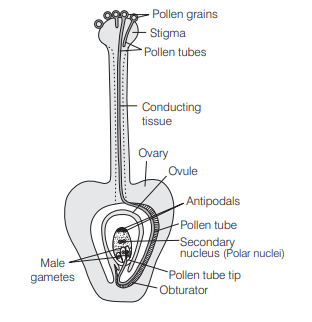Question
Double fertilisation is [NEET 2018]
(a) fusion of two male gametes with one egg
(b) fusion of one male gamete with two polar nuclei
(c) fusion of two male gametes of pollen tube with two different eggs
(d) syngamy and triple fusion
Answer/Explanation
Ans. (d)
Double fertilisation is the fusion of two male gametes to two different cells of the same female gametophyte. It consists of following two events
(i) Syngamy Fusion of the egg nucleus with one male gamete is called syngamy.
(ii) Triple fusion it is the fusion of second male gamete and central cell.
Concept Enhancer Syngamy results in the formation of diploid (2n) zygote. Triple fusion involves three nuclei, i.e. one of male gamete and two polar nuclei. It gives rise to a triploid ( )3n endosperm.

Fertilisation in an angiosperm through porogamy
Question
Double fertilisation is exhibited by [NEET 2017]
(a) gymnosperms
(b) algae
(c) fungi
(d) angiosperms
Answer/Explanation
Ans. (d)
Double fertilisation is the characteristic feature of angiosperms. In this type of fertilisation one male gamete fuses with an egg and forms zygote. The second male gamete fuses with diploid secondary nucleus of central cell to form a triploid primary endosperm nucleus.
Question
Through which cell of the embryo sac, does the pollen tube enter the embryo sac [CBSE AIPMT 2005]
(a) egg cell
(b) persistant synergid
(c) degenerated synergid
(d) central cell
Answer/Explanation
Ans. (c)
Egg apparatus is present towards the micropylar end of an ovule. Egg apparatus has two lateral synergid cells and one centrally located egg cell. During entry of pollen tube within the ovule synergid cells become disintegrate and provide path for entry of pollen tube within the chamber of embryo sac.
Question
In angiosperms pollen tubes liberate their male gametes into the [CBSE AIPMT 2002]
(a) central cell
(b) antipodal cell
(c) egg cell
(d) synergid
Answer/Explanation
Ans. (d)
The contents of the pollen tube are discharged in the synergid from where the first male gamete is transferred to the egg cell, while the other male gamete moves to the central cell through cytoplasmic current.
Question
Double fertilisation leading to initiation of endosperm in angiosperms require [CBSE AIPMT 2000]
(a) fusion of one polar nucleus and the second male gamete only
(b) fusion of two polar nuclei and the second male gamete
(c) fusion of four or more polar nuclei and the second male gamete only
(d) all of the above kinds of fusion in different angiosperms
Answer/Explanation
Ans. (b)
In angiosperms the endosperm is a special tissue which is formed as a result of triple fusion. In triple fusion the second male gamete fuses with secondary nucleus(diploid nucleus formed by fusion of two polar nuclei) to form triploid primary endosperm nucleus.
Question
Fertilisation involving carrying of male gametes by pollen tube is [CBSE AIPMT 1994]
(a) porogamy
(b) siphonogamy
(c) chalazogamy
(d) syngonogamy
Answer/Explanation
Ans. (b)
In angiosperms, the male gametes are carried by the pollen tube and such type of fertilisation or fusion of male and female gametes or syngamy is called siphonogamy. It was discovered by Strasburger (1884).
Question
Double fertilisation and triple fusion were discovered by [CBSE AIPMT 1993, 88]
(a) Hofmeister
(b) Nawaschin and Guignard
(c) Leeuwenhoek
(d) Strasburger
Answer/Explanation
Ans. (b)
Double fertilisation was discovered by Nawaschin (1898) in Fritilario and Lilium.It was confirmed by Guignard (1899). Syngamy (one male gamete fuse with egg cell to form zygote) and triple fusion (second male gamete fuses nucleus to with two polar nuclei or secondary nucleus to form triploid primary endosperm nucleus occurs simultaneously in angiosperms and this is called double fertilisation.
Question
Double fertilisation is fusion of [CBSE AIPMT 1991]
(a) two eggs
(b) two eggs and polar nuclei with pollen nuclei
(c) one male gamete with egg and other with synergid
(d) one male gamete with egg and other with secondary nucleus
Answer/Explanation
Ans. (d)
Double fertilisation deals with the fusion of one male gamete with egg to form zygote and the other male gamete with secondary nucleus to form Primary Endosperm Nucleus (PEN).
Question
Entry of pollen tube through micropyle is [CBSE AIPMT 1990]
(a) chalazogamy
(b) mesogamy
(c) porogamy
(d) pseudogamy
Answer/Explanation
Ans. (c)
Porogamy refers to the most common method by which the pollen tube enters the ovule through micropyle, e.g. lily. When pollen tube enters through chalaza, it is known as chalazogamy and when it enters laterally through integuments, then such process is known as mesogamy.
Question
Generative cell was destroyed by laser but a normal pollen tube was still formed because [CBSE AIPMT 1989]
(a) vegetative cell is not damaged
(b) contents of killed generative cell stimulate pollen growth
(c) laser beam stimulates growth of pollen tube
(d) the region of emergence of pollen tube is not harmed
Answer/Explanation
Ans. (a)
Pollen grain or microspore divides mitotically forming a larger tube or vegetative cell and a small generative cell. Since, vegetative cell gives rise to pollen tube and generative cell divides to form two male gametes, thus if a generative cell is destroyed by laser, a normal pollen tube will still form through the vegetative cell which is undestroyed.
Question
Total number of meiotic divisions required for forming 100 zygotes/100 grains of wheat are [CBSE AIPMT 1988]
(a) 100
(b) 75
(c) 125
(d) 50
Answer/Explanation
Ans. (c)
Total number of meiotic divisions required for forming 100 zygote/100 grains of wheat are 125. Zygote is the fusion product of pollen grains and egg. 100 zygotes require 100 pollen grains and 100 embryo sacs. 100 pollen grains are produced from 25 microspore mother cells while 100 embryo sacs are formed from 100 functional megaspores which as a result being produced by 100
megaspore mother cells, since three, out of four megaspores degenerate in each case.
